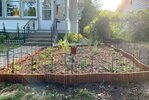
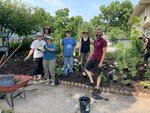
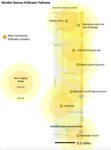

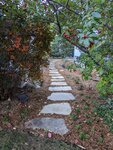
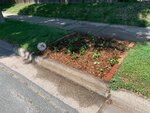
There’s a new pathway in southwest Minneapolis, but it’s not for people.
The Nicollet Avenue Pollinator Pathway is a series of 50 native plant gardens along and around Nicollet Avenue (from Lake Street to Diamond Lake Road) that provide food sources and nesting space for the rusty patched bumble bee, Minnesota’s state bee and a federally endangered species.
The project is a collaboration between the Lyndale, Kingfield, and Tangletown neighborhoods. In 2022, the neighborhood associations received a $40,000 grant from the Minnesota Board of Water and Soil Resources to rebuild habitat for pollinators like the rusty patched bumble bee that was lost due to urbanization.
“You can look around and be like there’s so many gardens in my area, but there’s still a huge lack of native plant life for a lot of native species,” said Sarah Linnes-Robison, director of the Kingfield and Lyndale Neighborhood Associations. “We can’t do too much.”
The rusty patched bumble bee, named for the rust-colored patch on its back, was once widespread across the eastern United States, the Upper Midwest, and parts of Canada. But, its population has declined over the last several decades and it is now found in only a fraction of its former range, according to the state Department of Natural Resources. Minnesota is home to a significant portion of its remaining population.
Andrea Siegel of the Tangletown Neighborhood Association, said they choose Nicollet Avenue as the focus for the project because it runs through all three neighborhoods. Six of the gardens that make up the pathway are larger community sites maintained by organizations such as Minnesota Adult and Teen Challenge and Solomon’s Porch and Yoga Sanctuary. The rest were planted by residents who applied for and were selected to participate in the project. While anyone could apply, residents were chosen based on proximity to each other because the bumblebees have a relatively small foraging radius of about half a mile.
Participants received free native plants, compost, and mulch to help install their gardens. Siegel said the rusty patched bumble bee is a “very picky eater” and feeds on a diet of constancy, meaning they’ll only eat one particular plant for a certain period of time. For that reason, they required each garden to have the same core group of plants including wild geranium, purple prairie clover, wild bergamot, giant hyssop, and culver’s root so each will have similar flowers blooming at the same time and the bees won’t have to travel far to eat.
Most of the gardens were planted in early June, and each should be marked with a small circular sign indicating they are part of the pollinator pathway. Siegel notes that while the gardens may not be much to look at right now, next year they should begin to attract bees and other pollinators.
“If you were to go out and look at everyone’s gardens this year they’re probably not going to look very impressive, there’s not going to be a lot of blooming or anything like that,” Siegel said. “In year two or year three we hope to do some garden tours so people can start to see more established blooming plants, and then that’s when people will start to see the butterflies and bees show up.”
Garden tours are part of the next phase of the project: Education. By teaching people about the rusty patched bumble bee and showing them what a pollinator-friendly garden can look like, Linnes-Robinson hopes it will encourage more residents to plant similar species in their own yards.
“Hopefully that education encourages people to plant similar species to help native insects that feed in this way thrive, instead of striving for a super unique garden that has plants that no one else has,” she said. “There’s room for that, but there’s also a need for people to be planting the same species that their neighbors do to make sure that there’s enough food for [the rusty patched bumble bee].”
Comments
No comments on this item Please log in to comment by clicking here